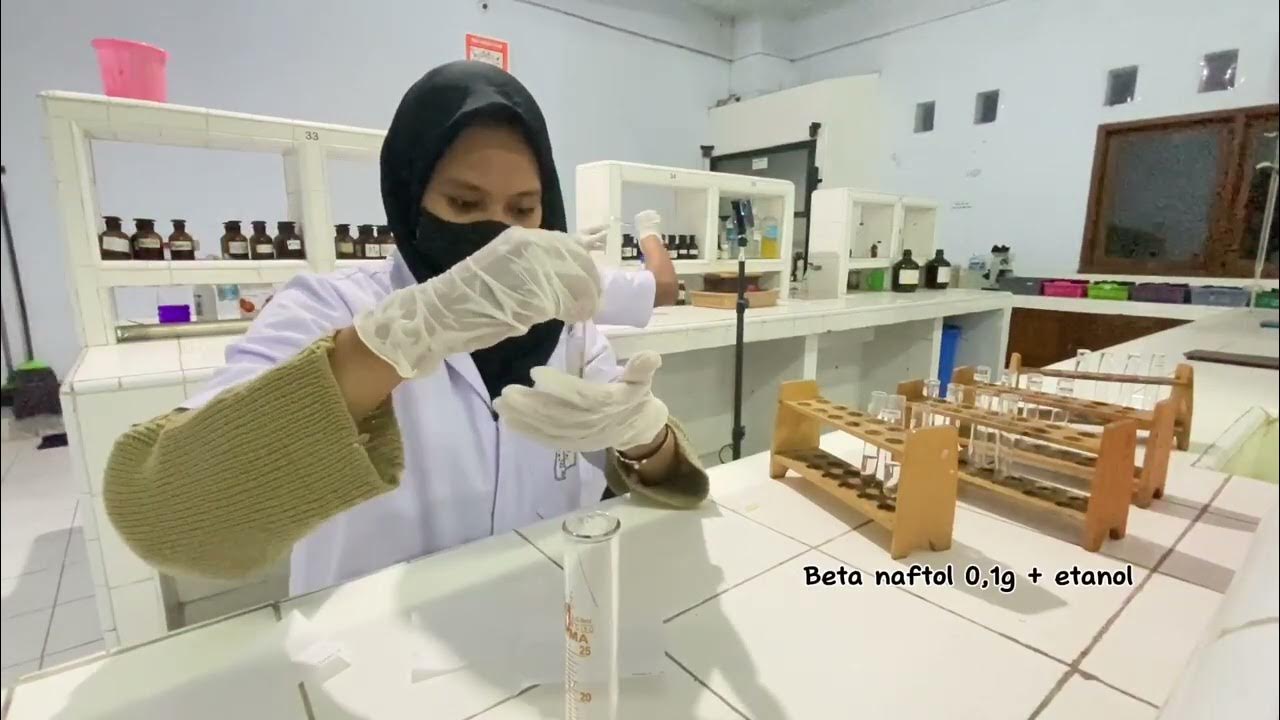Cara Uji Fitokimia Alkaloid Sampel Segar dengan Reagen Mayer
Summary
TLDRIn this video, Rony Ardiansyah explains how to identify alkaloid compounds in fresh pandan leaf samples using Mayer's reagent as part of a natural materials chemistry practicum. He details the process, from preparing the leaves by cutting and grinding them, to extracting the compounds with chloroform and ammonia. Rony demonstrates the use of H2SO4 to separate the layers, followed by the addition of Mayer's reagent to identify alkaloids. A color change to white confirms the presence of alkaloids in the sample, completing the identification process.
Takeaways
- 😀 Alkaloids are nitrogenous compounds often found in plants, with a characteristic heterocyclic structure.
- 😀 The experiment aims to identify alkaloids in fresh pandan leaves using Mayer's reagent.
- 😀 Fresh pandan leaves are cut into smaller pieces to ease grinding and extraction of compounds.
- 😀 Sand is added during grinding to help break open the plant cells and facilitate compound extraction.
- 😀 Chloroform is used to extract the compounds from the pandan leaves, turning the solution green when successful.
- 😀 Ammonia is added to the chloroform solution to further help dissolve the compounds from the pandan leaves.
- 😀 After adding ammonia, the solution is separated into two layers: an acid layer on top and a chloroform layer below.
- 😀 The acid layer, containing the extracted alkaloids, is separated for further testing.
- 😀 Mayer's reagent, consisting of mercuric chloride and potassium iodide, is added to the acid layer to identify alkaloids.
- 😀 A positive test for alkaloids is indicated by the formation of a white precipitate, signaling the presence of alkaloids in the sample.
Q & A
What is an alkaloid?
-An alkaloid is a group of nitrogen bases, mostly heterocyclic, found in plants. These compounds typically contain nitrogen and have a variety of biological effects.
What is the role of Mayer's reagent in identifying alkaloids?
-Mayer's reagent is used to test for the presence of alkaloids. When added to an acid layer containing alkaloids, it causes a color change, indicating the presence of these compounds.
How are alkaloids identified in fresh pandan leaf samples?
-Alkaloids in fresh pandan leaf samples are identified by using a method involving chloroform extraction, ammonia addition, and the use of Mayer's reagent to detect the presence of alkaloids.
What is the significance of adding sand during the preparation of the pandan leaf sample?
-The sand is used as a cell breaker during the grinding of the pandan leaves, helping to release the compounds inside the cells of the plant.
Why is chloroform used in the extraction process of alkaloids from pandan leaves?
-Chloroform is used to dissolve the compounds in the pandan leaves. It extracts the alkaloids and other compounds from the leaves, which can then be tested.
What happens after chloroform is added to the ground pandan leaves?
-Once chloroform is added, it dissolves the compounds in the pandan leaves, causing the solution to change color, typically turning green, indicating the compounds have been drawn out.
How does ammonia play a role in the alkaloid identification process?
-Ammonia is added to the chloroform solution to further separate the compounds. It helps in the extraction process, allowing the compounds to be more effectively drawn into the solution.
What is the purpose of shaking the mixture after adding sulfuric acid?
-Shaking the mixture after adding sulfuric acid helps mix the solution, resulting in two layers: an acid layer at the top and a chloroform layer at the bottom. The layers are separated to isolate the alkaloids.
How can we confirm that the sample contains alkaloids after the separation process?
-After separating the acid and chloroform layers, Mayer's reagent is added to the acid layer. A color change to white indicates the presence of alkaloids.
What are the key tools and materials used in the alkaloid identification process in this experiment?
-The key tools and materials include fresh pandan leaves, a mortar and pestle, chloroform, ammonia, H2SO4 (sulfuric acid), Mayer's reagent, scissors, cotton, test tubes, and sand.
Outlines

This section is available to paid users only. Please upgrade to access this part.
Upgrade NowMindmap

This section is available to paid users only. Please upgrade to access this part.
Upgrade NowKeywords

This section is available to paid users only. Please upgrade to access this part.
Upgrade NowHighlights

This section is available to paid users only. Please upgrade to access this part.
Upgrade NowTranscripts

This section is available to paid users only. Please upgrade to access this part.
Upgrade NowBrowse More Related Video

Percobaan 1 Identifikasi senyawa Fenol

Qualitative tests for organic functional groups – practical video | 16–18 years

PANDAN 🌱: Natural vs Extract, Is It That Different? | Testing On Indonesian Pandan Pudding 🍮

Branches of Chemistry

Aldehyde & Ketone Reactions Experiment

Test for Carbohydrates, Proteins and Fats - MeitY OLabs
5.0 / 5 (0 votes)